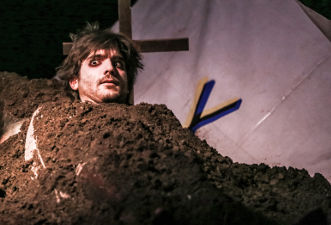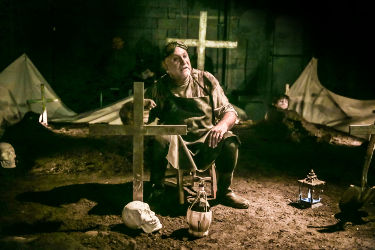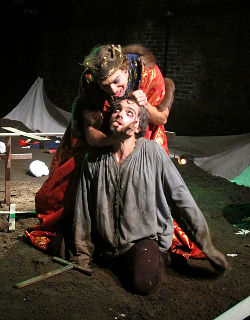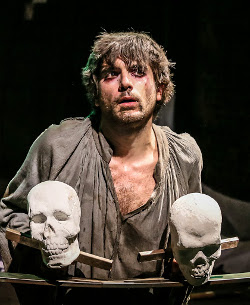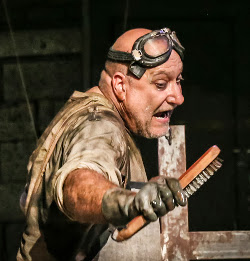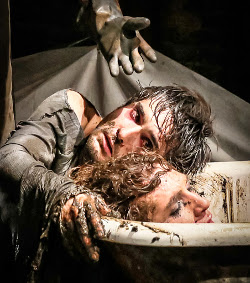
TWO VIEWS OF "HAMLET
HALLUCINATIONS"
by Larry
Litt
by Kelly Aliano
Adapted and Directed by Dario D’Ambrosi If you love that whacko Danish bad boy Hamlet as I do, then Dario D’Ambrosi’s Current Teatro Patologico production is a you must be there to believe it. Think Hamlet on a dark Halloween night in a vilely unkempt Catholic graveyard meets Rocky Horror Picture Show having sex on Freud’s couch. This darkly macabre and comic graveyard is extended into one of the most important acting circus rings in the long history of Shakespearean adaptations.
Why? Because the question “To be or not to be?” is finally, fatefully answered. This obtuse query that sets off tragic consequences in the original has obsessed audiences and Western philosophers since it was first asked by this sad teenager. But what if it were really an idiot’s delight? A sexual predator’s justification for any and all perversities? A directive to send those you love to their graves with glee?
Is this six word inner monologue the theater’s unknowing projection of Zen detachment? A ‘so what, fuck you, does anything really matter when everything is totally air and failing energy?’ Why all these questions in this review?
Because the philosophical underpinnings of D’Ambrosi’s version are a complete reversal of roles that have always begged to be questioned. First because he understands that Hamlet himself is a Northern European noble phenomenon. He’s perfectly at home with murder and bloodshed because that’s his Danish royal military heritage. The difference is Hamlet asks himself if it’s at all necessary or would suicide be the better course. When the answer is ‘yes’ then revenge is the only path, the path to total destruction.
What D’Ambrosi does best is show us how perverse that decision is. How the inner Hamlet is already tortured with unnatural desires before he asks his fateful question. He acknowledges he is born to kill and welcomes being killed, having sex without love and loving without consummation. Then it all comes to a pitiful end in the ubiquitous grave where any life, reflected or not, is destined.
With the exception this time that the Mortician has replaced the Gravedigger. The wisdom the Mortician imparts to the corpse are the sanest words I’ve heard in any theater in a very long time. In the midst of death and depravity a sudden light appears with direction for Life, not Death as the Gravedigger expounds.
Actor Giacomo Rocchini gives the boyish Hamlet a endless ego maniacal madness often instigated by despondent sex. Mauro F. Cardinali as Gertrude, Claudius, The Ghost and Ophelia is a master of quick change in all his physical and psychic aspects. His vocal changes are an experiment in identity crises. D’Ambrosi's Mortician is an enlightened earthy master of living philosophy for the Dead and Buried.
Luisa Viglietti’s set with Francesco Santalucia’s inspired jazz dirges create a primordial graveside for the high energy action. 90 minutes raced by, a thriller that won’t stop demanding attention. D’Ambrosi exhumes “Hamlet,” renews him for a contemporary audience then sends us home with message to continue our own struggle for Life.
"Hamlet Hallucinations" Why do we continue to regularly adapt the story of “Hamlet”? What does it continue to say to our changing times? Clearly, the famous "To Be or Not to Be" soliloquy--which acts as the organizing principle behind the thematic elements of Dario D'Ambrosi's "Hamlet Hallucinations" at La MaMa--still has much to say to us as mortal beings upon the earth. And yet, when synthesized on its own, abstracted from the narrative trappings of Shakespeare's masterpiece, much of its valence seems, if not lost, then certainly obscured.
The aesthetics of D'Ambrosi's production, from the moment the theater doors are opened, are exquisite. The scene, a graveyard of dirt, marked with crucifixes, is dark and ominous, matching perfectly with the tone of this eerie play. The spookiness of this work is what is most effective about it; in a season of the year known for its ghost stories and haunted houses, D'Ambrosi has cleverly found the most jarring aspects of Hamlet's tale. I found myself if not frightened, then at least with a slight chill down my spine. For a play set in a cemetery, I must assume this was the point. Rather than highlighting the Bard's linguistic genius, this production finds his most disconcerting ideas, characterizations, and ideologies. In this production, "to be or not to be" throws into relief our mortal obsession with death, as part and parcel of our human condition. Hamlet rises from his grave to face his most serious demons: his father's ghost, his adulterous mother, his murderous uncle, his beloved Ophelia, and his almost uncomfortably jovial gravedigger. These moments are seen in isolation, more a study of the levels of psychosis than a story.
The actors are admirable in what must be a trying and tiring 90 minutes of tour-de-force-style work. They find a lot of depth in the minimal amount of Elizabethan text with which they have to work. The occasional switches to Italian actually heighten the disconcerting overall quality of the production, a kind of extra layer of alienation. It is also impressive how they interact with their very real stage set surroundings, letting the dirt engulf their bodies as the madness overtakes their minds. For a while, the slow pace of the show is creepily fun, almost a Halloween Noh performance based loosely on "Hamlet." Ultimately, however, the play's great downfall is its seeming lack of purpose. Even the presence of a second scene, operating as an extra-narrative epilogue after the Shakespearean events have been completed, does not tie up all of the confusion that this production brings to light. Perhaps this sense of uncertainty--a feeling that one does not or cannot know the answers regarding the meaning of life--is the overall meaning of the production. And yet, when one's source material is as rich as this play's is it seems less than fulfilling. "Hamlet" still has a great deal to say to our contemporary world about what it means to be human. Here, there are perhaps too many layers of dirt on top, preventing any of those points from coming to light.
|
| home |
columnists | reviews |
cue-to-cue | welcome |
| museums | recordings |
coupons | publications |
classified |
